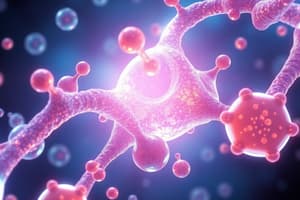Podcast
Questions and Answers
What is the correct formula for maltose formed from two glucose molecules?
What is the correct formula for maltose formed from two glucose molecules?
- C12H24O12
- C6H22O12
- C6H12O6
- C12H22O11 (correct)
What is a key difference between triglycerides and phospholipids?
What is a key difference between triglycerides and phospholipids?
- Phospholipids have two fatty acids and a phosphate group, triglycerides have three fatty acids. (correct)
- Triglycerides have a phosphate group while phospholipids do not.
- Triglycerides are hydrophilic while phospholipids are hydrophobic.
- Triglycerides contain four fatty acids while phospholipids contain three.
Which type of bond is responsible for the secondary structure of a polypeptide?
Which type of bond is responsible for the secondary structure of a polypeptide?
- Disulfide bonds between cysteine residues
- Ionic bonds between side chains
- Peptide bonds between amino acids
- Hydrogen bonds between atoms in the peptide chain (correct)
What can be said about the carboxyl and amino groups in a polypeptide?
What can be said about the carboxyl and amino groups in a polypeptide?
Given the DNA sequence 5’ - TAGGCCT - 3’, what is its complementary strand?
Given the DNA sequence 5’ - TAGGCCT - 3’, what is its complementary strand?
Flashcards
Maltose
Maltose
A type of carbohydrate formed by the joining of two glucose molecules through a dehydration reaction, resulting in a chemical formula of C12H22O11.
Triglyceride
Triglyceride
A fat molecule composed of glycerol with three fatty acid chains attached, forming a hydrophobic molecule used for energy storage.
Phospholipid
Phospholipid
A lipid molecule similar to triglycerides, but with one fatty acid replaced by a phosphate group, giving it a hydrophilic head and hydrophobic tails, important for cell membranes.
Secondary Structure of Proteins
Secondary Structure of Proteins
Signup and view all the flashcards
Tertiary Structure of Proteins
Tertiary Structure of Proteins
Signup and view all the flashcards
Study Notes
Dehydration Reaction and Maltose Formation
- Glucose (C6H12O6) molecules combine via a dehydration reaction to create maltose (C12H22O11).
- The reaction is: C6H12O6 + C6H12O6 → C12H22O11.
Fat (Triglyceride) vs. Phospholipid Structure
- Triglycerides: Glycerol molecule with three fatty acids attached.
- Phospholipids: Glycerol molecule with two fatty acids and a phosphate group attached.
Polypeptide Structure and Bonds
- Secondary structure: Hydrogen bonds between atoms in the peptide chain.
- Tertiary structure: Interactions between amino acid side chains.
Greek Letters α and β in Structure
- α-glucose/β-glucose: Different arrangements of hydroxyl groups around the carbon atoms of glucose. Glycosidic bonds determine the specific arrangement.
- α-helix/β-pleated sheet: Common secondary structures in proteins, formed by hydrogen bonds within the polypeptide backbone. α-helices are coiled, β-pleated sheets are folded.
Amino Acid Groups in Polypeptides
- Polypeptides retain amino and carboxyl groups from the constituent amino acids from the ends.
- The carboxyl group of one amino acid bonds with the amino group of the next to create a peptide bond. This leaves an amino group at one end (NH2) and a carboxyl group at the other (COOH) of the polypeptide chain.
DNA Complementary Strand
- Given sequence: 5' - TAGGCCT - 3'
- Complementary strand: 3' - ATCCGGA - 5'
Studying That Suits You
Use AI to generate personalized quizzes and flashcards to suit your learning preferences.




